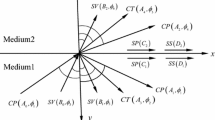Summary
The propagation velocities and the variation of the amplitudes of thermo-acoustical waves in thermo-plastic materials are theoretically investigated. The constitutive equations of anisotropic thermo-plastic materials are derived from the concept of imaginary decomposition of the deformation rate tensor into the elastic and plastic contributions and from that of the plastic potential. From generalized Vernotte's heat conduction law the propagation condition of the jumps of the velocity gradients and of the temperature rate is obtained. In isotropic materials and in the case of a normal stress vector on the wave front we have two purely mechanical transverse waves and two thermo-longitudinal coupled waves. Formulae for the velocities and amplitudes are quite similar with those for thermo-elastic materials. The variation of the amplitude is discussed. There are, in general, three effects on the variation, that is, the non-planar, heat conduction and plastic flow effects. The transverse waves are subjected only to the non-planar effect, while the thermo-longitudinal waves may grow or decay according to the above three effects.
Similar content being viewed by others
References
T. Tokuoka, Yield conditions and flow rules derived from hypo-elasticity,Arch. Rational Mech. Anal., 42 (1971) 239–252.
C. Truesdell, Hypo-elasticity,J. Rational Mech. Anal., 4 (1955) 83–133, 1019–1020.
T. Tokuoka, Generalized Prandtl-Reuss plastic materials, I. Constitutive equation for finite deformation,Mem. Fac. Engng., Kyoto Univ., 33 (1971) 186–192.
T. Tokuoka, Thermo-hypo-elasticity and derived fracture and yield conditions,Arch. Rational Mech. Anal., 46 (1972) 114–130.
T. Tokuoka, Constitutive equations of thermo-plastic materials,Trans. Japan Soc. Aero. Space Sci., 16 (1973) 51–59.
P. Vernotte, La véritable équation de la chaleur,Compt. rend. Acad. Sci., 246 (1958) 3154–3155.
E. B. Popov, Dynamic coupled problem of thermoelasticity for a half-space taking account of the finiteness of the heat propagation velocity,J. Appl. Math. Mech. (PMM), 31 (1967) 349–356.
J. D. Achenbach, The influence of heat conduction on propagating stress jumps,J. Mech. Phys. Solids, 16 (1968) 273–282.
P. J. Chen, On the growth and decay of one-dimensional temperature rate waves,Arch. Rational Mech. Anal. 35 (1969) 1–15.
T. Tokuoka, Thermo-acoustical waves in linear thermo-elastic materials,J. Eng. Math., 7 (1973) 115–122.
T. Tokuoka, Variation of amplitudes of thermo-acoustical waves of arbitrary form in isotropic linear thermo-elastic materials,J. Eng. Math., 7 (1973) 361–366.
T. Tokuoka, Generalized Prandtle-Reuss plastic materials, II. Characteristic surfaces and acceleration wave propagation,Mem. Fac. Engng, Kyoto Univ., 33 (1971) 193–200.
T. Tokuoka, Generalized Prandtl-Reuss plastic materials, III. Growth and decay of acceleration waves and propagating boundary surfaces,Mem. Fac. Engng, Kyoto Univ., 33 (1971) 201–210.
T. Tokuoka, Constitutive equations and wave propagation of anisotropic perfectly plastic materials,Trans. Japan Soc. Aero. Space Sci., 15 (1972) 22–27.
T. Tokuoka, Propagation velocities and amplitudes of thermo-acoustical waves in thermo-plastic materials,Trans. Japan Soc. Aero. Space Sci., (in press).
T. Tokuoka, Growth and decay of thermo-acoustical waves in thermo-plastic materials,Trans. Japan Soc. Aero. Space Sci., 16 (1973) 102–112.
R. von Mises, Mechanik der festen Körper im plastisch deformablen Zustand,Göttingen Nachr. math. phys., K. 1913 (1913) 582–592.
T. Y. Thomas,Concepts from Tensor Analysis and Differential Geometry, second edition, Academic Press, New York-London (1965).
T. Y. Thomas, Extended compatibility conditions for the study of surfaces of discontinuity in continuum mechannics,J. Math. Mech., 6 (1957) 311–322, 907–908.
T. Y. Thomas,Plastic Flow and Fracture in Solids, Academic Press, New York-London (1961).
C. Truesdell and R. Toupin,The Classical Field Theories, Handbuch der Physik III/1, Chap. C., edited by S. Flügge, Springer-Verlag, Berlin-Göttingen-Heidelberg (1960).
B. D. Coleman and M. E. Gurtin, Waves in materials with memory, II. On the growth and decay of one-dimensional acceleration waves,Arch. Rational Mech. Anal., 19 (1965) 239–265.
Author information
Authors and Affiliations
Rights and permissions
About this article
Cite this article
Tokuoka, T. Thermo-acoustical waves in thermo-plastic materials. J Eng Math 8, 9–22 (1974). https://doi.org/10.1007/BF02353700
Received:
Issue Date:
DOI: https://doi.org/10.1007/BF02353700




